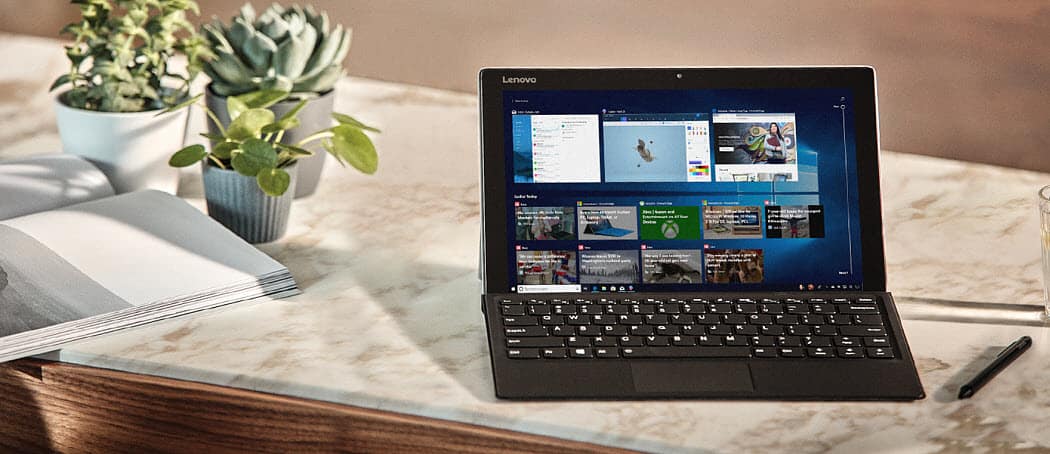How to Improve Windows 10 Boot Up Time with Fast Startup

If you’re Windows 10 computer isn’t booting up as quickly as you’d like, one thing you can do is verify the Fast Startup feature is enabled. Here’s how.
If you’re Windows 10 computer isn’t booting up as quickly as you’d like, one thing you can do is verify the Fast Startup feature is enabled. Here’s a look at what it is and how to enable it to help improve boot-up time – even when using an SSD.
Important Note: To make sure you have the Fast Startup feature available, you need to enable Hibernation. For more on that, read our guide on how to enable Hibernate Mode in Windows 10. First introduced in Windows 8.1, Fast Startup is a hybrid power mode that combines the Hibernation mode and shutdown properties. It’s kind of like Hibernation, which is a power setting you’ve seen in previous versions of Windows. When it’s enabled, Windows saves some of your PC’s system files to hibernation file when you power down your computer. Simply put, when you power your computer back on, Windows uses the saved files in the hibernation file created by enabling Fast Startup instead of from scratch. So, once enabled, it helps your PC boot up quicker. If you want an even more technical explanation, you can read this MSDN article. It should be enabled by default on most PCs, but it could be disabled if you did an upgrade from Windows 8.1 to Windows 10, but it’s easy to turn on. Go to Settings > System > Power & Sleep and then click or tap Additional power settings. Next, in the Power Options screen click or tap Choose what the power buttons do. Now make sure that Turn on fast startup is checked under the Shutdown Settings section. If it’s not, at the top of this window click Change settings that are currently unavailable. And then check it and save your changes. That’s all there is to it! To see how much boot time it saves, shut down your computer and boot it up again. Restart isn’t affected by this change, only when you completely power off your PC and then start it up again. It’s also worth noting that Fast Startup can cause problems if you use Wake-on-LAN, so you might want to disable the feature. Another tip you might want to try for faster startup time is to disable Windows 10 startup programs.What is Fast Startup?
Enable Windows 10 Fast Startup






7 Comments
Leave a Reply







Jack
February 23, 2016 at 12:57 pm
Thanks Brian. After the section Password protection on wakeup, I do not have Shutdown Settings. Any ideas please?
Jack in Australia.
Ziggy
February 23, 2016 at 6:55 pm
This setting made a huge difference for my laptop, and startup time is very quick. Without it startup would take up to two to three minutes. So it does work!
However, with a pc desktop (which I had made for me) this setting fails to power off the computer, leaving it in a continuous “power-on” until I physically push the off button. To resolve that problem I went into the bios and resolved the issue from there. The pc desktop is equipped with an “oldish” gigabyte motherboard, but its startup time is now also very quick.
Bob Kahovec
February 28, 2016 at 5:31 pm
Brian,
When I click on “Choose What Power Buttons Do”, the only options that appear are
“Sleep” and “Lock”. There are NO “Fast Start” or “Hibernate” boxes to check.
I upgraded to WIN 10 from WIN 7 with no problems, if that makes a difference.
winblogpress
February 28, 2016 at 6:45 pm
You did not go through the tutorial well Sir. After you clicked on “Choose What Power Buttons Do”, click on “Change settings that are currently unavailable” on the next page.
Then scroll down and enable Hibernate first. Repeat the process to enable Fast start Up.
Give me my five.
Bob Kahovec
February 28, 2016 at 7:08 pm
You did not read my comment well, Sir. Clicking the “Change Settings” does nothing
because there are NO “Hibernate” or “Fast Start” boxes to enable.
The only options available are “Sleep” and “Lock!!!
Ziggy
February 29, 2016 at 1:28 am
@Bob Kahovec: Follow the link provided which may be of some assistance for you.
http://www.tenforums.com/tutorials/2859-hibernate-enable-disable-windows-10-a.html
The registry entries (provided as a download) worked for my laptop which, in turn, considerably sped up my laptop’s start time.
When I updated from Windows 7 I had forgotten that I had disabled Hibernation. The link provided addressed my issue of slow startup and, may I add, my forgetfulness!
Bob Kahovec
February 29, 2016 at 11:07 am
Thanx Ziggy —– That did the trick.